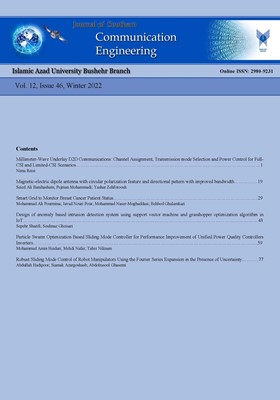طراحی سیستم تشخیص نفوذ مبتنی بر آنومالی با استفاده از ماشین بردار پشتیبان و الگوریتم بهینهسازی ملخ در اینترنت اشیا
الموضوعات :
1 - دانشجوی کارشناسی ارشد مهندسی فناوری اطلاعات، دانشکده فنی و مهندسی، دانشگاه آزاد اسلامی واحد علوم و تحقیقات، ایران
2 - استادیار گروه کامپیوتر، دانشکده فنی مهندسی ، دانشگاه آزاد اسلامی واحد پردیس، ایران
الکلمات المفتاحية: اینترنت اشیا, ماشین بردار پشتیبان, تشخیص نفوذ مبتنی بر آنومالی, الگوریتم بهینه سازی ملخ,
ملخص المقالة :
امروزه شبکههای کامپیوتری نقش مهم و کاربردی در ارتباطات و تبادل دادهها دارند و در زندگی انسانها انواع مختلفی از شبکههای کامپیوتری پا به عرصه وجود گذاشته است که یکی از آنها شبکه اینترنت اشیاء است. در اینترنت اشیا گرههای شبکه میتوانند اشیا هوشمند باشد و از این نظر این شبکه دارای گرههای زیادی است و ترافیک بالایی در این شبکه وجود دارد. مانند هر شبکه کامپیوتری، اینترنت اشیا با چالشها و مشکلات خاص خود مواجه است که یکی از آنها مسأله نفوذ به شبکه و ایجاد اختلال در آن است. در این پایاننامه تمرکز بر روی تشخیص نفوذ مبتنی بر آنومالی در شبکه اینترنت اشیا با استفاده از دادهکاوی است. در این پژوهش پس از جمعآوری و آمادهسازی دادهها از ماشین بردار پشتیبان بهبودیافته با الگوریتم بهینهسازی ملخ به عنوان روش پیشنهادی در جهت تشخیص نفوذ مبتنی بر آنومالی در اینترنت اشیا استفاده میشود و الگوریتم بهینهسازی ملخ پارامترهای ماشین بردار پشتیبان را به صورت بهینه تعیین میکند و نتایج با طبقهبندهای بگینگ و k- نزدیکترین همسایه و ماشین بردار پشتیبان پایه بر اساس انواع خطا و تحلیل آماری خطا مورد مقایسه قرار میگیرد. نتایج شبیهسازی نشان از دقت 97.2% در روش پیشنهادی و عملکرد بهتر در مقایسه با سایر روشها دارد.
[1] A. J. Siddiqui and A. Boukerche, "TempoCode-IoT: temporal codebook-based encoding of flow features for intrusion detection in Internet of Things," Cluster Computing, vol. 24, no. 1, pp. 17-35, 2021, doi: 10.1007/s10586-020-03153-8.
[2] A. Khraisat and A. Alazab, "A critical review of intrusion detection systems in the internet of things: techniques, deployment strategy, validation strategy, attacks, public datasets and challenges," Cybersecurity, vol. 4, no. 1, pp. 1-27, 2021, doi: 10.1186/s42400-021-00077-7.
[3] B. S. Khater, A. Wahab, A. W. Bin, M. Y. I. B. Idris, M. A. Hussain, and A. A. Ibrahim, "A lightweight perceptron-based intrusion detection system for fog computing," Applied Sciences, vol. 9, no. 1, p. 178, 2019, doi: 10.3390/app9010178.
[4] J. Bard, “What Is Data Mining?” PowerKids Press, 2018.
[5] M. Roopak, G. Y. Tian and J. Chambers, "An Intrusion Detection System Against DDoS Attacks in IoT Networks," 10th Annual Computing and Communication Workshop and Conference (CCWC), 2020, pp. 0562-0567, doi: 10.1109/CCWC47524.2020.9031206.
[6] M. Safaldin, M. Otair, and L. Abualigah, "Improved binary gray wolf optimizer and SVM for intrusion detection system in wireless sensor networks," Journal of ambient intelligence and humanized computing, vol. 12, no. 2, pp. 1559-1576, 2021, doi: 10.1007/s12652-020-02228-z.
[7] N. Huber, S. R. Kalidindi, B. Klusemann, and C. J. Cyron, ”Machine Learning and Data Mining in Materials Science,” Frontiers Media SA, 2020.
[8] N. Islam et al., "Towards machine learning based intrusion detection in IoT networks," Comput. Mater. Contin, vol. 69, pp. 1801-1821, 2021, doi: 10.32604/cmc.2021.018466.
[9] S. Saremi, S. Mirjalili, and A. Lewis, "Grasshopper optimisation algorithm: Theory and application," Advances in Engineering Software, vol. 105, pp. 30-47, 2017, doi: 10.1016/j.advengsoft.2017.01.004.
[10] Sh. Ghafarian and K. Rezaei and A. Kafash, ” A survey on intrusion detection approaches in IOT”, Third National Conference on Applied Research in Electrical, Computer and Medical Engineering,2019
[11] V. Kumar, A. K. Das, and D. Sinha, "UIDS: a unified intrusion detection system for IoT environment," Evolutionary Intelligence, vol. 14, no. 1, pp. 47-59, 2021, doi: 10.1007/s12065-019-00291-w.
[12] X. S. Yang, “Introduction to Algorithms for Data Mining and Machine Learning”. Elsevier Science & Technology, 2019.
_||_
[1] A. J. Siddiqui and A. Boukerche, "TempoCode-IoT: temporal codebook-based encoding of flow features for intrusion detection in Internet of Things," Cluster Computing, vol. 24, no. 1, pp. 17-35, 2021, doi: 10.1007/s10586-020-03153-8.
[2] A. Khraisat and A. Alazab, "A critical review of intrusion detection systems in the internet of things: techniques, deployment strategy, validation strategy, attacks, public datasets and challenges," Cybersecurity, vol. 4, no. 1, pp. 1-27, 2021, doi: 10.1186/s42400-021-00077-7.
[3] B. S. Khater, A. Wahab, A. W. Bin, M. Y. I. B. Idris, M. A. Hussain, and A. A. Ibrahim, "A lightweight perceptron-based intrusion detection system for fog computing," Applied Sciences, vol. 9, no. 1, p. 178, 2019, doi: 10.3390/app9010178.
[4] J. Bard, “What Is Data Mining?” PowerKids Press, 2018.
[5] M. Roopak, G. Y. Tian and J. Chambers, "An Intrusion Detection System Against DDoS Attacks in IoT Networks," 10th Annual Computing and Communication Workshop and Conference (CCWC), 2020, pp. 0562-0567, doi: 10.1109/CCWC47524.2020.9031206.
[6] M. Safaldin, M. Otair, and L. Abualigah, "Improved binary gray wolf optimizer and SVM for intrusion detection system in wireless sensor networks," Journal of ambient intelligence and humanized computing, vol. 12, no. 2, pp. 1559-1576, 2021, doi: 10.1007/s12652-020-02228-z.
[7] N. Huber, S. R. Kalidindi, B. Klusemann, and C. J. Cyron, ”Machine Learning and Data Mining in Materials Science,” Frontiers Media SA, 2020.
[8] N. Islam et al., "Towards machine learning based intrusion detection in IoT networks," Comput. Mater. Contin, vol. 69, pp. 1801-1821, 2021, doi: 10.32604/cmc.2021.018466.
[9] S. Saremi, S. Mirjalili, and A. Lewis, "Grasshopper optimisation algorithm: Theory and application," Advances in Engineering Software, vol. 105, pp. 30-47, 2017, doi: 10.1016/j.advengsoft.2017.01.004.
[10] Sh. Ghafarian and K. Rezaei and A. Kafash, ” A survey on intrusion detection approaches in IOT”, Third National Conference on Applied Research in Electrical, Computer and Medical Engineering,2019
[11] V. Kumar, A. K. Das, and D. Sinha, "UIDS: a unified intrusion detection system for IoT environment," Evolutionary Intelligence, vol. 14, no. 1, pp. 47-59, 2021, doi: 10.1007/s12065-019-00291-w.
[12] X. S. Yang, “Introduction to Algorithms for Data Mining and Machine Learning”. Elsevier Science & Technology, 2019.


